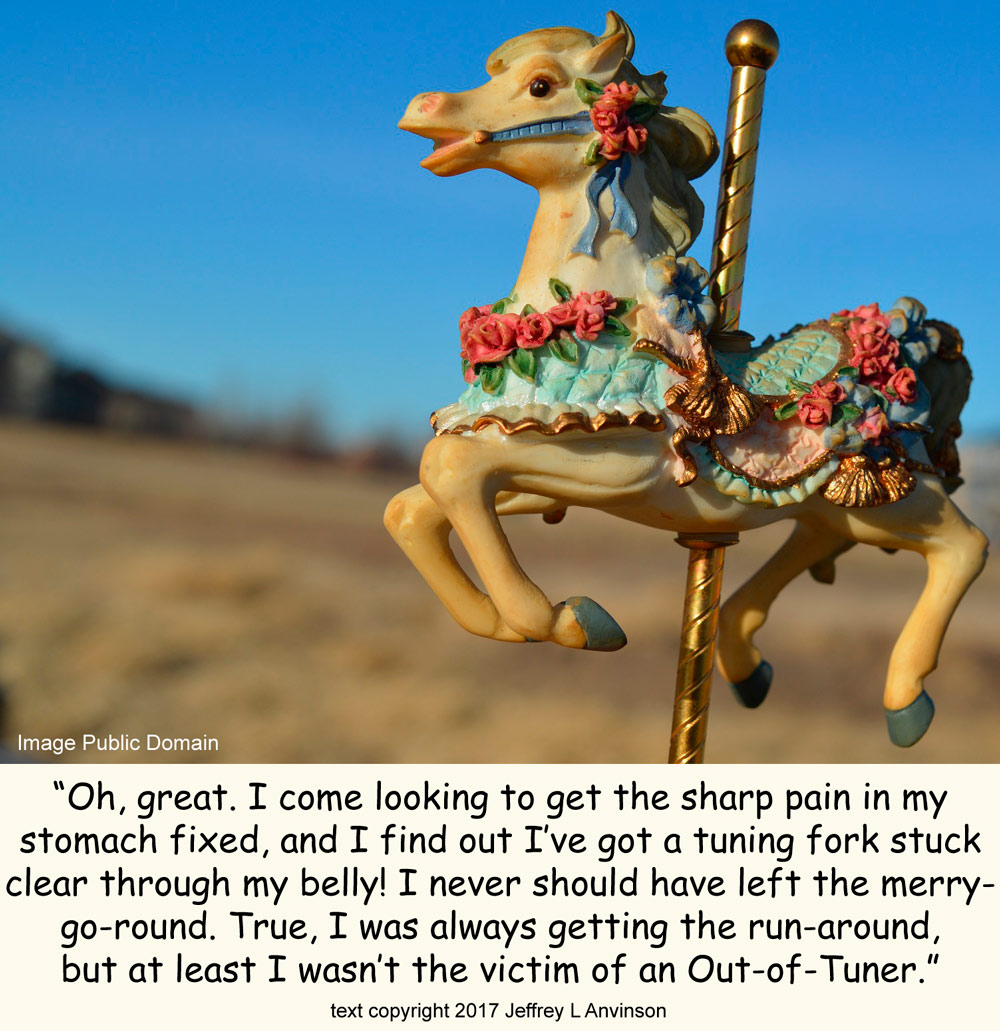Converting Major Scales Into Other Scales
Welcome to the Scale-Go-Round!

If you're into scales, you may like this "down and dirty" way to convert major scales into other types of scales, such as natural minor, minor pentatonic, major pentatonic, etc.
There are two basic steps involved.
- Create a major scale. Here's a page on this website that will show you how: The Major Scale and Its Diatonic Triads
- While following a scale conversion formula (see below), change or omit various degrees of the scale according to the following rules. If a scale conversion formula contains a . . .
- number: use the scale degree note from the major scale unchanged, for example, "1"
- flat (b) plus a number, for example, "b2": use the scale degree note from the major scale and lower it one half-step
- sharp (#) plus a number, for example, "#5": use the scale degree note from the major scale and raise it one half-step
- Omit notes where scale degree numbers are omitted
In this case however, the sharp and flat signs mean to alter a note by a half-step higher or lower, which may already be a sharp or a flat. (I know; this is confusing, right?)
Let's take an example. Say you met Ms. Bb on the street and you decided to lower her to convert her to a note in a different scale. (I just couldn't resist anthropomorphizing notes into people). Ms. Bb would be lowered one-half step and her name changed to"B". Or, let's say you met Mr. F# in a bar and the conversion formula said you need to "flat" him. You would lower Mr. F# and change his name to "F". (F# is a natural at doing this, by the way.) :-)
Confused yet? I bet. Just remember that when you're converting a major scale using scale conversion formulas, sharps and flats literally mean to lower and raise notes by one-half step, not to necessarily make them flats or sharps. Chord symbols work the same way. If you're still confused, hang in there. Let's do some examples.
Some Examples
Let's start with a typical scale conversion formula. In this case it's the one used to convert a major scale into harmonic minor.
1 2 b3 4 5 b6 7
Let's start with the simplest major scale of them all: C major. This is what it looks like in scale degree order from one to seven: C D E F G A B
Let's convert it into a C harmonic minor scale, which has the conversion formula 1 2 b3 4 5 b6 7
- "1" means to retain the first scale degree as it is: C
- "2" means to retain the second scale degree as it is: D
- "b3" means to take the third scale degree and lower it one-half step: Eb
- "4" and "5" mean to retain the fourth and fifth scale degrees as they are: F and G
- "b6" means to lower the sixth scale degree one-half step: Ab
- "7" means to retain the seventh scale degree as it is: B
Line these new notes up in alphabetical order and you get C D Eb F G Ab B (add another C at the end if you want it to sound right), the notes in a c harmonic minor scale.
 Isn't this fun? I feel like I'm on a merry-go-round ride at the fair - a bit dizzy but happy.
Isn't this fun? I feel like I'm on a merry-go-round ride at the fair - a bit dizzy but happy.
Let's try another one. Then I'll get to the good part where I give you a whole clef-load of scale conversion formulas so you can convert to your heart's content!
For our second example, let's convert an Ab major scale to a natural minor one. Start with the Ab major scale: Ab Bb C Db Eb F G. (If you're not sure how I created this, return to the page mentioned above, sit in a corner, and don't move till you understand it!)
Apply the natural minor scale conversion formula: 1 2 b3 4 5 b6 b7
- "1", "2, "4", and "5" are retained from the Ab major scale: Ab, Bb, Db, and Eb
- "b3", "b6", and "b7" direct us to lower those scale degrees one-half step: C to Cb, F to Fb, G to Gb.
"But hold on to your merry-go-round horses!", you may exclaim. "Isn't Cb the same as B, and Fb the same as E?"
 To which my answer would be, "Yes, they sound the same, but just like your first grade teacher taught you, spelling is important! Scales are virtually always in alphabetical order and no letter can be used more than once in a row." (You can finally send that thank you note you've been meaning to send to your first grade teacher, Ms. Sara Spellright.)
To which my answer would be, "Yes, they sound the same, but just like your first grade teacher taught you, spelling is important! Scales are virtually always in alphabetical order and no letter can be used more than once in a row." (You can finally send that thank you note you've been meaning to send to your first grade teacher, Ms. Sara Spellright.)Oh! Stop the train! Did I just see a glint in your eye and a big bright light bulb appear like a UFO hovering above your head?
You exclaim, "So *that's* why we have notes like Cb, B#, Fb, E# - and even stranger ones like Gx (g double sharp) and Cbb (c double flat)! I finally get it!" Then I watch as you raise a huge one-gallon glass of your favorite beverage to the ceiling and say, as the Norwegians do, "Skål!".
Now, as promised - drum roll please - a bass-clef-load (kind of like a "boat load", I would think) of scale conversion formulas. (By the way, I don't know the official highfalutin' music theory term for "scale conversion formulas"; I made that up. So if you run into a music theorist, scream and hightail it in the opposite direction. ;-) No, really, you should ask her/him if they know the official term. Get ready for a twenty-minute lecture before you get a good answer, which is usually not going to be definitive because music is chock full of anomalies. ;-) If you can afford the time to stick around for the lecture, and finally do find out the "official" music theory term for "scale conversion formulas", send me an email. (But leave out the lecture notes, OK?) ;-)
Scale Conversion Formulas for Common Scales
- Natural Minor: 1 2 b3 4 5 b6 b7
- Harmonic Minor: 1 2 b3 4 5 b6 7
- Jazz (melodic) Minor: 1 2 b3 4 5 6 7
- Classical ascending Melodic Minor: 1 2 b3 4 5 6 7
- Classical descending Melodic Minor: 1 2 b3 4 5 b6 b7
- Major Pentatonic: 1 2 3 5 6 (leave out 4 and 7)
- Minor Pentatonic: 1 b3 4 5 b7 (leave out 2 and 6)
- Blues: 1 b3 4 #4 (or b5) 5 b7 (leave out 2 and 6)
- Dorian: 1 2 b3 4 5 6 b7
- Phrygian: 1 b2 b3 4 5 b6 b7
- Lydian: 1 2 3 #4 5 6 7
- Mixolydian: 1 2 3 4 5 6 b7
- Aeolian (same as natural minor above)
- Locrian: 1 b2 b34 b5 b6 b7
Final Notes
("an F was in the boss's office trying to look sharp - he wanted a raise")
One more thing: This is not the only way to construct scales. There are probably more ways to create scales than there are to skin a cat. (Though I don't think there should be any of the latter. Cats deserve better.). So, like freshman music theory students sometimes do, don't get in an argument about the "right way" to create scales. Just stick to your guns - no, better yet - stick to your music theory notes - and do what works for you. Happy scale converting!
Thanks for reading!
Jeff Anvinson, owner/operator of JLA Music
Website and most graphics are created inhouse by Jeff Anvinson, Owner/Operator of JLA Music
Some graphics are purchased from Can Stock Photo, used by permission, and are Copyright
© Can Stock Photo
JLA Music takes care not to infringe on anyone's rights. Please contact us at jla@jlamusic.com if you have questions.
Copyright 2025 © Jeff Anvinson, JLA Music


